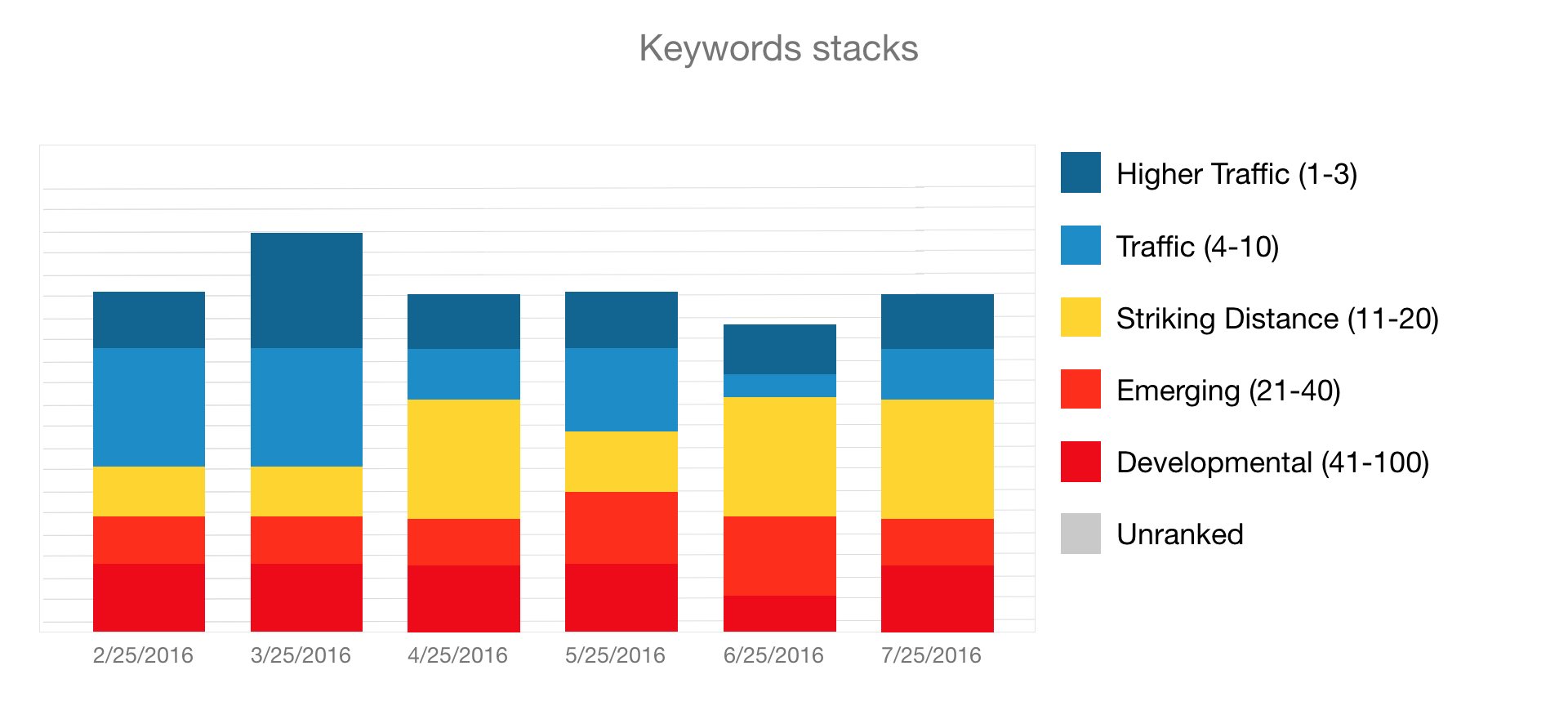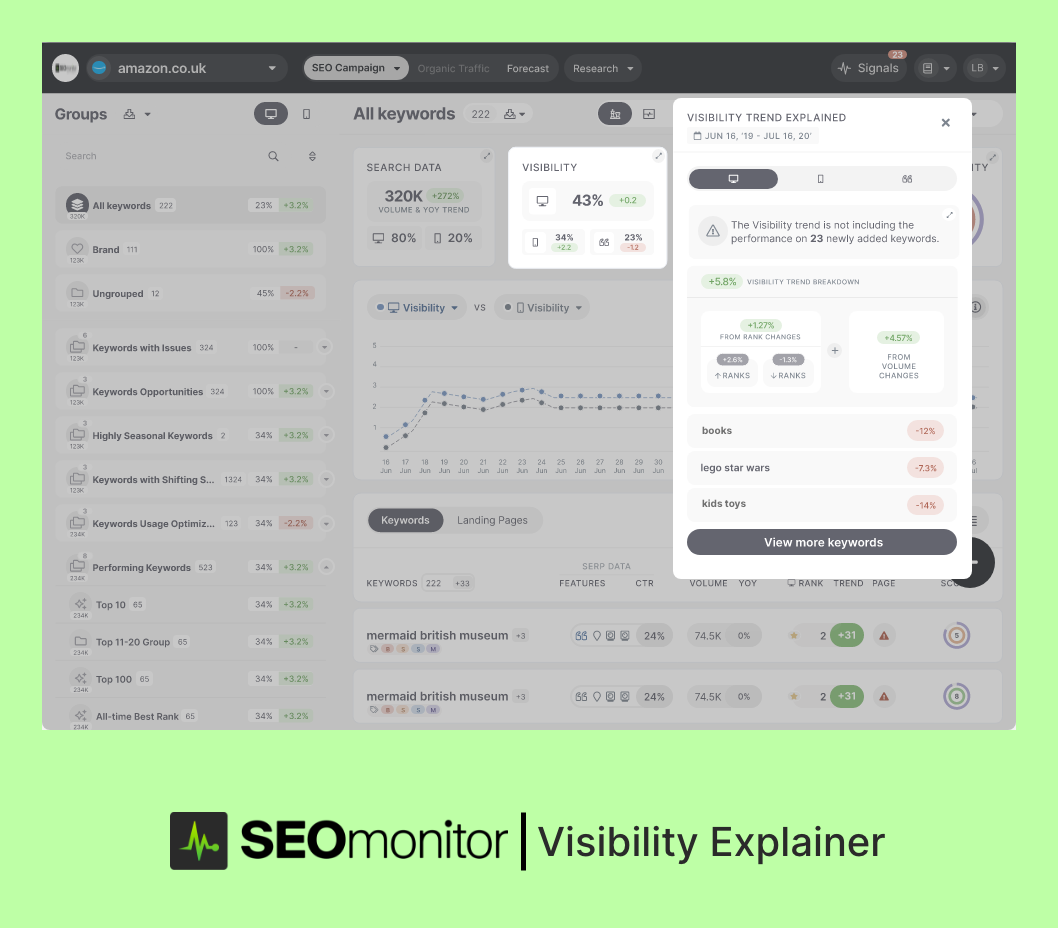30 Nov Search Visibility Then & Now: What’s the Reliable Way to Measure Your SEO Efforts? via @seomonitor
Keyword Stacks – Number of Keywords in top 1-3, 4-10, 11+
Another stop in the SEO industry’s quest of performance metrics: the keyword stacks, grouping them by the number of keywords in positions 1-3, 4-10, 11-20, etc.
Calculated as such, it is meant to showcase how a website is faring in search visibility based on the number of keywords in each “stack” – is it more on the top 1-3 side or on the 4-10 side?
So you will know the number of keywords generating a certain visibility number or percentage.
But there’s a catch.


What are the keyword stacks’ limitations?
Let’s say you have 50 keywords in top 3 and 150 keywords in 4-10. That can mean anything if the search volumes for each keyword are not considered, because there can be huge differences in how they impact your traffic. Maybe only 10 are relevant in terms of high search volumes for your chosen timeframe.
How do you know which ones to improve?
Also, there can be significant differences between the keywords in position 1, 2, and 3, so how do you know whether they’ve reached their best performance yet?
Visibility Metrics in the Industry
From average positions to keyword stacks, average click-through rates (CTRs) determined by all targeted keywords or based on rankings, the visibility metric is now a constant in the industry.
Yet, although they may go under the same generic name of “visibility”, these metrics differ quite a lot and have many flaws, as you’ll see below – being either iterations of the old metrics without necessarily solving their limitations or the same old metrics disguised with a new visibility name.
Let’s take a few existing visibility metrics under more careful scrutiny:
- The visibility calculated as an average of positions with different scores based on rankings is, at the end of the day, still an average position. So it suffers from the same limitations – changes based on adding or deleting keywords that can be misleading, scores that don’t necessarily explain room for growth, etc.
- The visibility calculated as estimated clicks based on rankings may give you a percentage that seems viable, but it’s still not reliable in showing you what those estimates mean for growth potential.
- The visibility calculated as average CTR (determined by all targeted keywords) – the organic clicks are still an estimation based on the top 10 positions and beyond, so, once again, you don’t know the growth potential. Plus, SERP features are included which makes the estimation more complex and fluctuant.
To conclude: all of them suffer from historical volatility and are unreliable, as they change not just based on performance, but based on your keywords list (adding/deleting keywords).
SEOmonitor’s Solution for the Visibility Metric
It’s clear that the need to identify a visibility metric that includes keywords and rankings and makes the connection with potential business outcomes is as strong as ever.
We believe that one formula of calculation helps determine the benchmark for success, without introducing too much complexity – an impression share in the organic results, which takes into account the rankings and monthly search volumes for every keyword in your list.
Expressed as a percentage, SEOmonitor’s Visibility is an impression share weighted against search volumes, making it a more accurate representation of how well the client’s website ranks in Google at a particular time for a list of keywords.
Plus, being an impression share, you have a clear, objective scale that doesn’t fluctuate in itself – from 0% to 100% (all targeted keywords in position 1), you know the reality of the website’s status and potential (no estimation-based guesses).
Why does it work in telling you the truth about your SEO performance better than other metrics of its kind?
- Because it includes search volumes, it helps you correlate your traffic data with seasonality and search trends. Also, due to our split of brand and non-brand organic traffic, focusing on the latter, you’ll know how search trends and seasonality impact your visibility. So it’s a performance-related metric which you can explain, optimize etc.
- We include automatic annotations on the Visibility graph every time there is a non-performance change, like including or excluding keywords from the campaign – while excluding the “false impact” from your performance.
- The explainer for enhanced transparency that shows you why you have certain visibility trends – we show you how rank changes and search trends affected the visibility for each keyword group in your campaign, and highlight the most impactful keywords.


If you need a metric that tells you the truth about your keyword groups fast, look no further!
SEOmonitor’s visibility is for groups like the rank is for the individual keyword, making it a good “compass” that shows you where you are and where you can go from here.
What Are Its Limitations?
This connection with search trends can be tricky sometimes and, in order to understand changes in the Visibility, you need to look at year over year search data and see how search volumes changed.
SERP features are also a prickly matter – as they take their share from the total search volume of a keyword, a calibration is required to paint the whole picture regarding the Visibility metric. This is actually something we’re currently developing at SEOmonitor for this quarter – so you’ll know the percentage from the total searches that actually end up clicking on your targeted site.
How Do SEO Agencies Use Seomonitor’s Visibility Metric?
The Strategy
The main idea behind “How visible your website/business actually is?” can be “translated” as follows:
- Looking at the total shares potential and the competitors’ status.
- Defining how much “room for growth” you have for your client.
That’s the first critical way for agencies to use our Visibility. Used as a “market share” indicator when applied to competitors, Visibility points at opportunities or as Erald Krasniqi, SEO specialist and SEOmonitor’s Business Development Manager, puts it:
“You measure potential first. The question SEOs are challenged to answer is – How much space does client X have to grow? That’s how you identify opportunities.”
Being expressed as an impressions share percentage, SEOmonitor’s Visibility will set the benchmark for the SEO strategy and further performance to achieve.
Let’s take an example for clarity purposes.
Say you’re in a highly competitive niche like the gaming or betting industries. If your main competitor has a Visibility of 75%, based on your prior keyword research and targeting, then you have a good opportunity to grow there and, even, surpass that business. That means that improving the rankings for a top 3 keywords group, for instance, would have a dramatic impact on business results.
Using the initial Visibility as a performance metric, you can then go and:
- Explain how this Visibility can directly connect to more sessions and conversions. Something that the client will want to know before approving the SEO strategy.
- Monitor the changes in Visibility compared to the initial version and how it impacts your SEO objectives.
The Monitoring & Reporting
As we’ve just mentioned, the initial Visibility is a good performance metric to start from. There are multiple ways an agency uses it to measure their SEO efforts and impact – with insights from Maria Cernatescu, Customer Service Manager at SEOmonitor:
- The desktop/mobile split: Depending on the business’ profile, one Visibility or the other can be in focus, so it’s important to know both. Plus, a blended version for your monthly reporting. This is also a great way to understand if both devices perform well, or one of them is falling behind and needs some technical help.
- The overall Visibility Trend: The agency can compare one day to another, one week to another, one month to another, or even YoY. Something simple, but important as you still compare the same thing, so there’s nothing misleading muddling your insights.
- The Visibility Trend on specific keyword groups: Maybe the overall visibility trend is good, but having it on different groups helps you spot where there’s a drop that pulls down the overall visibility. Or the overall visibility could be still, but “beneath the hood” there are groups that sink and others that improve. You can explain every level of detail to your clients.
These are just some examples of this metric’s relevance and how many purposes it can serve.
What’s important to acknowledge here is that when reporting, agencies can trust SEOmonitor’s Visibility metric values, as they’re not changing historically when some of the keywords are deleted.
In a Nutshell
SEO agencies need to check daily statuses of multiple SEO campaigns, which means thousands of keywords to analyze – a problem that had different solutions as search metrics evolved:
- The average position and visibility on keyword stacks appeared in the history of SEO as performance metrics, but they were both limited because they didn’t represent the whole status: Not making a direct connection between rankings and keyword quality attributes, these metrics introduced confusion and could be misleading.
- The visibility metrics that appeared in the search industry so far suffer from two important limitations. The performance is affected by changes of adding/deleting keywords, which shouldn’t be taken into account. And they’re based on estimates, so you don’t know for sure how much space there is to grow for your keywords.
As a reliable performance metric, SEOmonitor’s Visibility helps agencies:
- Create a “market share” snapshot in comparison to the client’s competitors and evaluate the client’s potential for growth.
- Establish the truth of the client’s SEO performance fast. The agency knows what keyword groups performed or changed, why they changed, and how that affected the client’s business.
- Monitor and report the monthly Visibility and correlate it with sessions, conversions, and business results.
Sorry, the comment form is closed at this time.